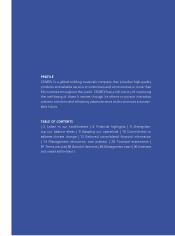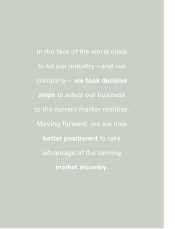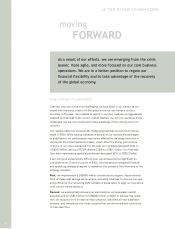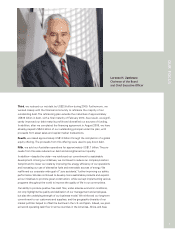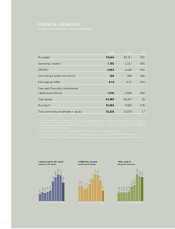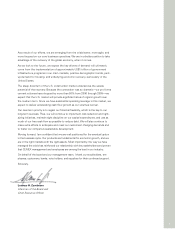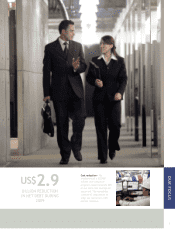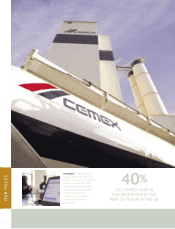Cemex 2009 Annual Report Download - page 12
Download and view the complete annual report
Please find page 12 of the 2009 Cemex annual report below. You can navigate through the pages in the report by either clicking on the pages listed below, or by using the keyword search tool below to find specific information within the annual report.
COMMITMENT
to address climate change
MOVING FORWARD
Our commitment to sustainable and responsible business
practices not only enables us to build a better world for
future generations, but also ensures our company’s long-
term competitiveness. As part of our global sustainability
strategy, we are undertaking a number of initiatives to
address the challenges posed by climate change.
We actively collaborate with stakeholders—inside and out-
side of our industry—to advance innovative ways to design,
construct, and operate more sustainable, energy-efficient
buildings. A prime example is our involvement in the World
Business Council for Sustainable Development (WBCSD).
Through our work with the WBCSD, we participated in the
three-year Energy Efficiency in Buildings initiative up to and
including the publication of its final report in April 2009.
Among the findings of this joint effort, we determined that
buildings are responsible for as much as 40% of the energy
used in most countries, and approximately 88% of this
energy is consumed during their life span for operation,
maintenance, and renovation. That is precisely the area in
which our industry can make one of the biggest contribu-
tions: to develop ready-mix concrete products that help
save energy during the lifetime of a building. When properly
designed and constructed, concrete buildings can improve
energy efficiency and can last for decades with little or no
maintenance. Led by our Global Center for Technology and
Innovation in Switzerland, our research labs are working
every day to design and develop more sustainable build-
ing materials, such as our high-insulation concrete forms
that help keep heat out in hot climates and prevent it from
escaping in cold weather, thus saving energy. Moreover,
the improved strength and density of our self-compacting
concrete increase the life of a building and reduce its main-
tenance costs.
Additionally, we are on track to achieve our goal of a 25%
reduction in specific CO2 emissions by 2015 from 1990
levels. Indeed, in 2009 we achieved a 20.7% reduction in
our CO2 emissions. To this end, we continued to expand
our use of more economical, environmentally friendly al-
ternative fuels and renewable sources of energy. In 2009,
we completed the Eurus wind farm in Oaxaca, Mexico.
Jointly developed by CEMEX and ACCIONA Energía, Eu-
rus is one of the largest wind farms in the world and the
largest wind power generator in Latin America. With 167
wind turbines, each generating up to 1.5 megawatts (MW)
of power, the Eurus wind farm has a production capacity
of 250 MW of power and can supply approximately 25%
of our Mexican plants’ energy needs. Financed, con-
Active collaboration
Through our work with the
WBCSD, we participated
in the three-year Energy
Efciency in Buildings
initiative up to and including
the publication of its nal
report in April 2009.
structed, and managed by ACCIONA, the wind farm will
achieve the second largest reduction of CO2 emissions—
approximately 600 thousand metric tons each year—of
any project registered under the United Nations’ Clean
Development Mechanism.
Furthermore, we substantially increased our use of
alternative fuels from 10.3% of our cement plants’ total
energy consumption in 2008 to 16.4% in 2009—thus
saving the fossil fuel equivalent of one million tons of coal
and avoiding 1.2 million tons of CO2 emissions. In Europe,
our plants’ use of alternative fuels is even higher. Thanks
to our shared best practices, today, alternative fuels ac-
count for close to 70% of the total fuel consumption in
our Chelm cement plant in Poland. This plant primarily
uses refuse-derived fuel (RDF), obtained from specialized
waste management plants that collect, treat, and turn
municipal and commercial waste into a solid, safe fuel.
In the UK, regulators recently granted us permission to
work with a joint-venture partner to construct and operate
an RDF facility near our Rugby plant. In 2009 we replaced
more than 40% of fossil fuels, such as coal, with RDF and
tires at our Rugby plant, creating significant environmental
and sustainability benefits such as a marked reduction of
nitrogen oxide emissions.
At CEMEX, we acknowledge the global challenges posed
by climate change and are committed to applying our
ideas, our skills, our technologies, and our determina-
tion to engage in developing a pathway to a low-carbon
economy.
For more information about our sustainability strategy and
practices, please visit our website at www.cemex.com/
sustainability.
10


